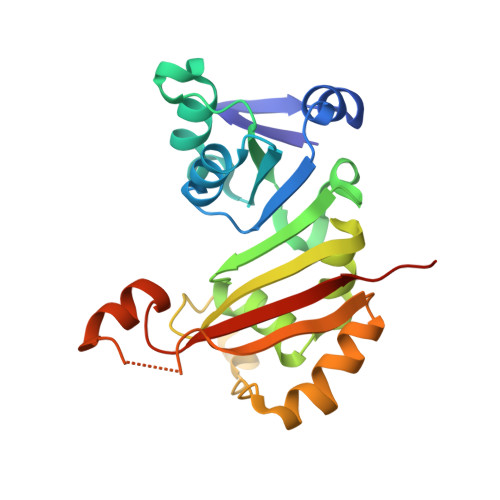30S Subunit-Dependent Activation of the Sorangium cellulosum So ce56 Aminoglycoside Resistance-Conferring 16S rRNA Methyltransferase Kmr.
Savic, M., Sunita, S., Zelinskaya, N., Desai, P.M., Macmaster, R., Vinal, K., Conn, G.L.(2015) Antimicrob Agents Chemother 59: 2807-2816
- PubMed: 25733511
- DOI: https://doi.org/10.1128/AAC.00056-15
- Primary Citation of Related Structures:
4RWZ, 4RX1 - PubMed Abstract:
Methylation of bacterial 16S rRNA within the ribosomal decoding center confers exceptionally high resistance to aminoglycoside antibiotics. This resistance mechanism is exploited by aminoglycoside producers for self-protection while functionally equivalent methyltransferases have been acquired by human and animal pathogenic bacteria. Here, we report structural and functional analyses of the Sorangium cellulosum So ce56 aminoglycoside resistance-conferring methyltransferase Kmr. Our results demonstrate that Kmr is a 16S rRNA methyltransferase acting at residue A1408 to confer a canonical aminoglycoside resistance spectrum in Escherichia coli. Kmr possesses a class I methyltransferase core fold but with dramatic differences in the regions which augment this structure to confer substrate specificity in functionally related enzymes. Most strikingly, the region linking core β-strands 6 and 7, which forms part of the S-adenosyl-l-methionine (SAM) binding pocket and contributes to base flipping by the m(1)A1408 methyltransferase NpmA, is disordered in Kmr, correlating with an exceptionally weak affinity for SAM. Kmr is unexpectedly insensitive to substitutions of residues critical for activity of other 16S rRNA (A1408) methyltransferases and also to the effects of by-product inhibition by S-adenosylhomocysteine (SAH). Collectively, our results indicate that adoption of a catalytically competent Kmr conformation and binding of the obligatory cosubstrate SAM must be induced by interaction with the 30S subunit substrate.
Organizational Affiliation:
Department of Biochemistry, Emory University School of Medicine, Atlanta, Georgia, USA.
















